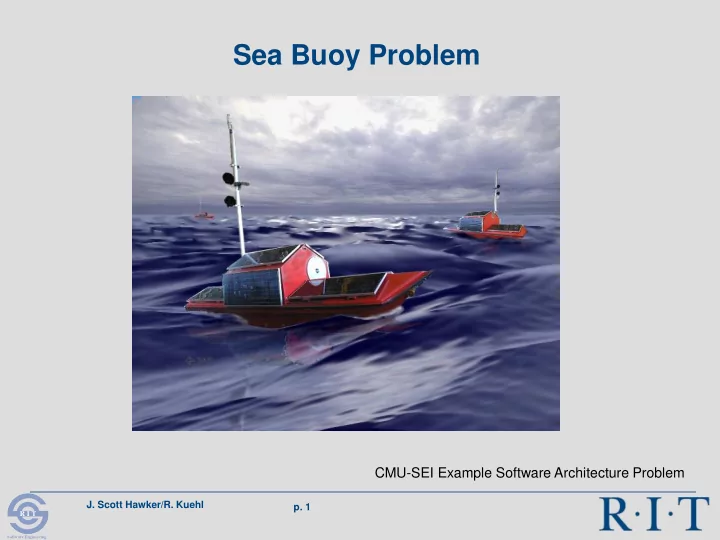

Sea Buoy Problem CMU-SEI Example Software Architecture Problem J. Scott Hawker/R. Kuehl p. 1 R I T Software Engineering
Functional Requirements Sea Buoy – a collection of untethered buoys acquire and maintain navigation and weather data, and provide the data to air and sea traffic Use cases: Collect environment data: Air and water temperature every 10 seconds Wind speed every 30 seconds Location data every 10 seconds Broadcast environment data Every 60 seconds to air and sea traffic On-demand broadcast 24-hour history Activate/deactivate emergency SOS signal Activate/deactivate red light, audio horn, and continuous broadcast of location data J. Scott Hawker/R. Kuehl p. 2 R I T Software Engineering
Architecturally Significant Requirements Single processor due to cost Must operate for one year without maintenance Support multiple sensors and accommodation for future sensor types Data formats depend on the sensors used Availability requirement – 24/7 On-demand broadcasts have priority over periodic broadcasts Emergency broadcasts have priority over all other broadcasts There is limited memory to save raw data beyond one month but summary statistical data must be persisted J. Scott Hawker/R. Kuehl p. 3 R I T Software Engineering
First Order Software Architecture Design How Did We get Here? J. Scott Hawker/R. Kuehl p. 4 R I T Software Engineering
Design Patterns and Tactics Synchronization - mutually exclusive access to data repositories Concurrent Pipelines - several real-time information pipelines Abstract Data Repository - handle sensor data format changes or addition of new sensor data types Simplex pattern- redundancy (same functions but not implementation) to achieve availability/reliability J. Scott Hawker/R. Kuehl p. 5 R I T Software Engineering
Synchronization ASRs Access to sensor data Single processor on which multiple processes reside, each of which perform computations on their own input data stream (messages) Each final output from the system must be produced within a specified time interval after the arrival of an input (message) and after all computations have been performed So completely process each message with a specified bounded end-to end latency — a deadline Contention for shared resources J. Scott Hawker/R. Kuehl p. 6 R I T Software Engineering
Synchronization Design Application: store sensor data then retrieve for periodic or on-demand transmission Stimuli: two or more periodic or sporadic input streams Response: end-to-end, worst-case latency Decisions: process relationships based on prioritization, scheduling, data-locking policy J. Scott Hawker/R. Kuehl p. 7 R I T Software Engineering
Add in Broadcast and Transmit Function Apply concurrent pipeline tactic - broadcast + transmission pipeline Broadcast has lower frequency than data acquisition, so assign it a lower priority but Broadcast could block sensor access to DB Effective priority of a pipeline is strongly related to the lowest priority process in the pipeline If transmission process priority is lower than broadcast priority, it effectively lowers the priority of the entire pipeline J. Scott Hawker/R. Kuehl p. 8 R I T Software Engineering
Apply Concurrent Pipeline Tactic J. Scott Hawker/R. Kuehl p. 9 R I T Software Engineering
Add in History Function “On - demand, broadcast 24 hour history” Quantitative analysis: what scheduling policy? History request is stochastic (event-driven, aperiodic) Data base synchronization and concurrent pipeline behavior is (assumed) deterministic Non blocking data base access, priority based preemptive task scheduling Apply rate monotonic scheduling (RMS) Static priority scheduling - the shorter the task duration, the higher the task's priority (versus round robin or time sharing for example) J. Scott Hawker/R. Kuehl p. 10 R I T Software Engineering
Add in SOS Function Analysis: Constraint: SOS, history and broadcast all use the transmission process SOS highest priority, then history, then broadcast Synchronization treated transmit as a critical section, thus a long history broadcast could block a high priority SOS Must make history broadcast preemptive e.g. transmit long message in small chunks, preempt between chunks J. Scott Hawker/R. Kuehl p. 11 R I T Software Engineering
Adding in Modifiability Requirements Modifications: add new sensor types Will new sensors produce data in same or different format? Are new sensors added or substitutes for existing sensors? Is a new environmental parameter being sensed? Apply a data indirection pattern to hide sensor changes: Abstract Data Repository Publish/Subscribe Considerations: data format conversion effect on process execution time, thus latency J. Scott Hawker/R. Kuehl p. 12 R I T Software Engineering
Current Architecture J. Scott Hawker/R. Kuehl p. 13 R I T Software Engineering
Adding Availability Simplex Pattern SOS function is critical Add redundancy that use different mechanisms Provide a separate hardware unit for SOS transmit J. Scott Hawker/R. Kuehl p. 14 R I T Software Engineering
Recommend
More recommend